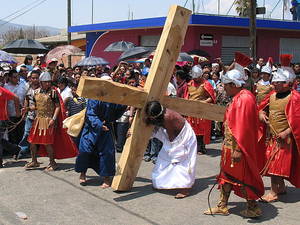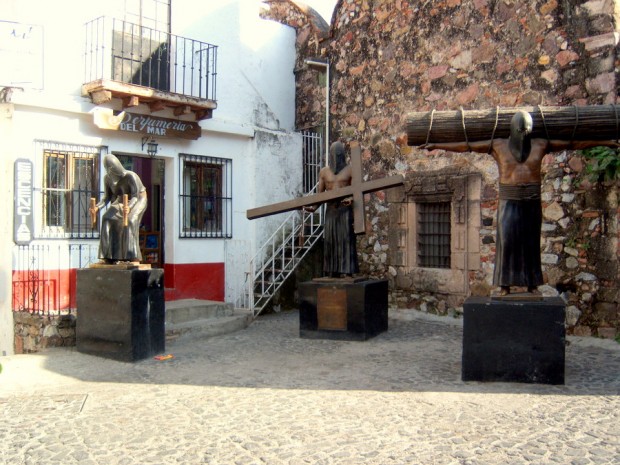By MoKa Hammeken (republished from April 2012)
In Mexico, the conquest of land by the Spanish in the 16th century was done differently than in other parts of the globe; at that time, the Catholic Kings and their empire spread their belief as a divine duty throughout all the newly “discovered” land, which is why religion permeates throughout Mexico in many of her customs.
 The friars, in charge of evangelizing and indoctrination of the indigenous pueblos, had the principal hurdle of language and so they came up with ideas to make themselves understood through theater. The staging of biblical stories become a common practice and communities already immersed in faith have continued the tradition.
The friars, in charge of evangelizing and indoctrination of the indigenous pueblos, had the principal hurdle of language and so they came up with ideas to make themselves understood through theater. The staging of biblical stories become a common practice and communities already immersed in faith have continued the tradition.
One of the most important dates within the Catholic tradition (and Christianity) is Holy Week, particularly Maundy Thursday, Good Friday, Holy Saturday, and Easter, which together summarize the suffering of Christ, as well as his resurrection, and are key dates in sustaining Christianity.
Among the representative traditions is the famous Via Crusis, or Stations of the Cross. Throughout Mexico, this is reenacted with thirteen stations through prayer, symbolizing different moments within the Passion.

Here in Puerto Peñasco there is such a reenactment, on a small scale, though this is also done on a much larger stage in other parts of the country. For example, in Mexico almost everyone has heard of the communities of Iztapalapa near Mexico City (possibly soon to be named as a World Heritage site) or Taxco, in the southern state of Guerrero. Iztapalapa tries to present the most faithful representation of the stations of the cross, according to the Bible, while Taxco takes on another form, filled with symbolism in interpreting the date.
Puerto Peñasco also participates in this tradition and performs the Via Crucis on Good Friday, [in 2013 this will begin at 10 a.m. along Blvd. Josefa Ortiz and the procession will make its way to Nuestra Sra. de Guadalupe Church]; it is brief though impressive. An individual representing Christ carries a wooden cross along the thirteen stations; he falls, suffers, cries, and forgives, up until he is symbolically crucified.
Watch for this reenactment if you are near Blvd. Josefa Ortiz on Friday; if you have the opportunity to observe and follow the procession, it is a magnificent example of faith moving mountains.
El Viacrucis
En México la conquista del territorio por medio de los españoles en el siglo XVI, se dio de manera muy diferente que en otras regiones del globo; en ese entonces los reyes católicos y su imperio esparcieron su creencia como un deber por todo el nuevo territorio descubierto y obtenido, por esto en México está tan permeada la religión en muchas costumbres.
Los frailes, encargados de la evangelización y adoctrinación de los pueblos, tenían como principal impedimento el lenguaje y entonces idearon una forma de hacerse entender; la teatralización. La escenificación de episodios bíblicos se volvió una práctica común y los pueblos ya inmersos en la fe continuaban solos el recordatorio.
Entonces podemos hablar que una de las más importantes fechas en la tradición católica es la Semana Santa, en especial, el jueves santo, el viernes santo, el Sábado de Gloria y el Domigo de Resurrección (o Pascua), que resumen el sufrimiento de Cristo y su resurrección y son los días de significado clave en que se sustenta el cristianismo.
Dentro de las tradiciones de representación esta el famoso Viacrucis. En todo México y en toda Iglesia se pasan por trece estaciones orando, que simbolizan diferentes momentos en la Pasión.
Esto es a pequeña escala, y hay representaciones de ésto mismo en grande ¿Un ejemplo? Casi todos hemos escuchado hablar de Iztapalapa (tal vez pronto Conmemorado Patrimonio de la Humanidad) y Taxco que llevan este espectáculo hasta lo impresionante; el primero intentando ser lo más fiel posible a los hechos sucedidos, según la historia de la Biblia, y el segundo, con otra forma cargada de simbología de interpretar la fecha.
Peñasco también participa de esta tradición y hace un recorrido de Viacrucis el viernes Santo por el Malecón a las 12 del día. Es breve pero impactante. Una persona interpreta a Jesús y carga la cruz por las trece estaciones; cae, sufre, llora, perdona, hasta que simulan su crucifixión y muerte.
Por ello mismo extremen sus precauciones el viernes por el área del Malecón, y si pueden, observar y seguirles pues, crean o no, es un magnífico ejemplo de la fe mueve montañas.
